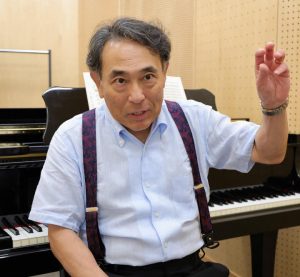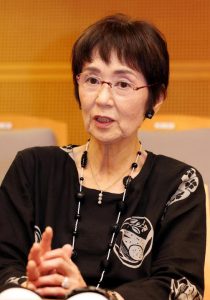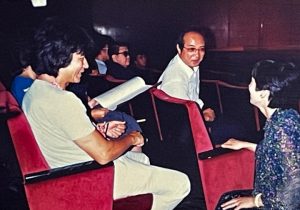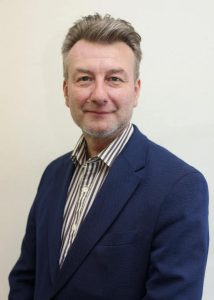Seiji Ozawa and A-bombed Hiroshima, Part 3: Musicians carry on their intuited sense of Ozawa’s “intentions”
Aug. 8, 2024
by Miho Kuwajima, Staff Writer
Seiji Ozawa, sympathetic to the victims of the atomic bombing over the duration his life spanning 88 years, conveyed his sense of urgency about nuclear weapons through his conductor’s baton. His wishes and feelings are being carried on by second-generation A-bomb survivor musicians from Hiroshima City and the Hiroshima Symphony Orchestra, an organization that has adopted as its slogan “Music for Peace.”
“Mr. Ozawa went out into the world 14 years after the end of the war, paving a path where none had existed before. He was our benefactor, and without him, I wouldn’t be where I am today,” said Kazufumi Yamashita, 62, a resident of Tokyo who is a conductor and a professor at the Tokyo University of the Arts.
Mr. Yamashita graduated from the Hiroshima branch of the Toho Music School for Children, which was led by Ozawa’s mentor, Hideo Saito, who died in 1974 at the age of 71. He started studying the cello under the direction of Mr. Saito in the fourth grade of elementary school.
Mr. Ozawa was someone Mr. Yamashita greatly admired as a young boy. In December 1973, Mr. Ozawa conducted in Hiroshima for the first time at a concert performed by the Toho Gakuen Orchestra. He was thrilled by the performance of Strauss’ symphonic poem “Don Quixote,” led by Mr. Ozawa’s majestic conducting. “Mr. Ozawa, very active in the international classical music world with its formidable racial barriers, was a real hero,” recalled Mr. Yamashita.
Mr. Yamashita was blessed with the opportunity to learn directly from Mr. Ozawa when he entered the Toho Gakuen School of Music. “Mr. Ozawa would conduct as if he was telling a story. He taught me how to verbalize conducting techniques based on his experiences in Europe and the United States,” said Mr. Yamashita.
When he went overseas, Mr. Yamashita became further aware of Mr. Ozawa’s commanding presence. From 1985 to 1989, he worked as an assistant to Herbert von Karajan, known by the nickname ‘the emperor,’ until his death. “He trusted me because I was a student of Mr. Ozawa,” said Mr. Yamashita.
When his mother Hiroko, an A-bomb survivor, died in 2014 at the age of 87, Mr. Yamashita began to get a sense of his mission as a second-generation A-bomb survivor. In recent years, he has poured his energies into conducting “Genbaku Shokei” (in English, “Little landscapes of Hiroshima”), a work that the Philharmonic Chorus of Tokyo has performed over generations.
“I’ve had never heard from Mr. Ozawa about his deep connection to Hiroshima, including his uncle’s experience in the atomic bombing. But, I sensed his strong intentions,” recalled Tomiko Kojiba, 72, a composer who lives in Tokyo.
In December 1985, at Carnegie Hall in New York, the Boston Symphony Orchestra, for which Mr. Ozawa served as music director and conductor, performed the U.S. premiere of “Hiroshima Requiem,” which was composed by Ms. Kojiba. It was unusual that a piece written by a still-unknown Japanese composer was selected to be performed in a regular performance by a renowned orchestra in a revered music hall.
Four months earlier, at a peace concert conducted by the legendary Leonard Bernstein in Hiroshima City, Ms. Kojiba’s piece “Hiroshima —” was performed for the first time in the world. Mr. Ozawa, while observing a rehearsal, remarked to her, “This is a beautiful piece. Could you give me the score? I’d like to play it.”
Ms. Kojiba said, “I was simply amazed. Soon after, I was contacted by the Boston Symphony Orchestra. They had quickly changed their program and inserted ‘Hiroshima —’ at the top.”
In New York City newspapers, favorable reviews praised how audiences were able to share in the suffering and fear of the A-bomb survivors and experience a moment of peace when listening to the short, excellent piece by Ms. Kojiba. They also wrote about how Mr. Ozawa’s superb conducting greatly added to the performance.
Ms. Kojiba said, “Opposition to a piece based on the theme of the atomic bombing could have been expected there. However, Mr. Ozawa’s powerful presence and strong determination led the U.S. premier to success and worldwide exposure.” The piece has since been performed around the world and continues to convey the wishes and feelings of the people of the A-bombed Hiroshima.
Profile
Kazufumi Yamashita
Born in Hiroshima City’s Higashi Ward, Mr. Yamashita graduated from the Toho Gakuen School of Music in 1984 and then studied at Universität der Künste Berlin. In 1986, he gained prominence when he conducted the Berlin Philharmonic Orchestra in place of Herbert von Karajan, who had suddenly fallen ill. He is now music director of the Chiba Symphony Orchestra and a permanent conductor for the Osaka Symphony Orchestra.
Tomiko Kojiba
Born in Hiroshima’s Minami Ward, Ms. Kojiba graduated from the high school affiliated with Hiroshima University and finished postgraduate studies at the Tokyo University of the Arts. Her father was an atomic bomb survivor. In 2006, she received the Bekku Award for the piece “Mifuka no Nanatsu no Yokogao” (‘Seven unweathered profiles’), which touched on the theme of the A-bomb victims. She also is a recipient of the Akutagawa Composition Award. Since 2023, she has served as a visiting professor at the Tokyo College of Music.
Christian Arming, 53, music director of the Hiroshima Symphony Orchestra, and Tsugio Tokunaga, 77, music advisor for the orchestra, were close friends with Seiji Ozawa over many years.
Mr. Ozawa was a predecessor for Mr. Tokunaga, who also graduated from Toho Gakuen School of Music. From his time at university, Mr. Tokunaga played the violin in orchestras conducted by Mr. Ozawa. He said with appreciation, “Mr. Ozawa instantly captivated orchestra members. He had a one-of-a-kind charm about him. I think it’ll take a long time before we see another person like Mr. Ozawa.”
Christian Arming is music director of the Hiroshima Symphony Orchestra and served as music director of the New Japan Philharmonic, a group Mr. Ozawa helped found, for 10 years starting in 2003. “Mr. Ozawa was the first Asian conductor to work internationally. He was always humble despite his standing as a maestro. I learned a lot from him.” At the end of this month, a concert will be held in Tokyo in commemoration of Seiji Ozawa, with Mr. Arming conducting the orchestra as Mr. Ozawa’s disciple.
Mr. Arming plans to carry on his mentor’s intentions. “It is important to gather in the A-bombed Hiroshima, play music, and convey a message of peace.”
(Originally published on August 8, 2024)
Seiji Ozawa, sympathetic to the victims of the atomic bombing over the duration his life spanning 88 years, conveyed his sense of urgency about nuclear weapons through his conductor’s baton. His wishes and feelings are being carried on by second-generation A-bomb survivor musicians from Hiroshima City and the Hiroshima Symphony Orchestra, an organization that has adopted as its slogan “Music for Peace.”
“Mr. Ozawa went out into the world 14 years after the end of the war, paving a path where none had existed before. He was our benefactor, and without him, I wouldn’t be where I am today,” said Kazufumi Yamashita, 62, a resident of Tokyo who is a conductor and a professor at the Tokyo University of the Arts.
Mr. Yamashita graduated from the Hiroshima branch of the Toho Music School for Children, which was led by Ozawa’s mentor, Hideo Saito, who died in 1974 at the age of 71. He started studying the cello under the direction of Mr. Saito in the fourth grade of elementary school.
Mr. Ozawa was someone Mr. Yamashita greatly admired as a young boy. In December 1973, Mr. Ozawa conducted in Hiroshima for the first time at a concert performed by the Toho Gakuen Orchestra. He was thrilled by the performance of Strauss’ symphonic poem “Don Quixote,” led by Mr. Ozawa’s majestic conducting. “Mr. Ozawa, very active in the international classical music world with its formidable racial barriers, was a real hero,” recalled Mr. Yamashita.
Mr. Yamashita was blessed with the opportunity to learn directly from Mr. Ozawa when he entered the Toho Gakuen School of Music. “Mr. Ozawa would conduct as if he was telling a story. He taught me how to verbalize conducting techniques based on his experiences in Europe and the United States,” said Mr. Yamashita.
When he went overseas, Mr. Yamashita became further aware of Mr. Ozawa’s commanding presence. From 1985 to 1989, he worked as an assistant to Herbert von Karajan, known by the nickname ‘the emperor,’ until his death. “He trusted me because I was a student of Mr. Ozawa,” said Mr. Yamashita.
When his mother Hiroko, an A-bomb survivor, died in 2014 at the age of 87, Mr. Yamashita began to get a sense of his mission as a second-generation A-bomb survivor. In recent years, he has poured his energies into conducting “Genbaku Shokei” (in English, “Little landscapes of Hiroshima”), a work that the Philharmonic Chorus of Tokyo has performed over generations.
“I’ve had never heard from Mr. Ozawa about his deep connection to Hiroshima, including his uncle’s experience in the atomic bombing. But, I sensed his strong intentions,” recalled Tomiko Kojiba, 72, a composer who lives in Tokyo.
In December 1985, at Carnegie Hall in New York, the Boston Symphony Orchestra, for which Mr. Ozawa served as music director and conductor, performed the U.S. premiere of “Hiroshima Requiem,” which was composed by Ms. Kojiba. It was unusual that a piece written by a still-unknown Japanese composer was selected to be performed in a regular performance by a renowned orchestra in a revered music hall.
Four months earlier, at a peace concert conducted by the legendary Leonard Bernstein in Hiroshima City, Ms. Kojiba’s piece “Hiroshima —” was performed for the first time in the world. Mr. Ozawa, while observing a rehearsal, remarked to her, “This is a beautiful piece. Could you give me the score? I’d like to play it.”
Ms. Kojiba said, “I was simply amazed. Soon after, I was contacted by the Boston Symphony Orchestra. They had quickly changed their program and inserted ‘Hiroshima —’ at the top.”
In New York City newspapers, favorable reviews praised how audiences were able to share in the suffering and fear of the A-bomb survivors and experience a moment of peace when listening to the short, excellent piece by Ms. Kojiba. They also wrote about how Mr. Ozawa’s superb conducting greatly added to the performance.
Ms. Kojiba said, “Opposition to a piece based on the theme of the atomic bombing could have been expected there. However, Mr. Ozawa’s powerful presence and strong determination led the U.S. premier to success and worldwide exposure.” The piece has since been performed around the world and continues to convey the wishes and feelings of the people of the A-bombed Hiroshima.
Profile
Kazufumi Yamashita
Born in Hiroshima City’s Higashi Ward, Mr. Yamashita graduated from the Toho Gakuen School of Music in 1984 and then studied at Universität der Künste Berlin. In 1986, he gained prominence when he conducted the Berlin Philharmonic Orchestra in place of Herbert von Karajan, who had suddenly fallen ill. He is now music director of the Chiba Symphony Orchestra and a permanent conductor for the Osaka Symphony Orchestra.
Tomiko Kojiba
Born in Hiroshima’s Minami Ward, Ms. Kojiba graduated from the high school affiliated with Hiroshima University and finished postgraduate studies at the Tokyo University of the Arts. Her father was an atomic bomb survivor. In 2006, she received the Bekku Award for the piece “Mifuka no Nanatsu no Yokogao” (‘Seven unweathered profiles’), which touched on the theme of the A-bomb victims. She also is a recipient of the Akutagawa Composition Award. Since 2023, she has served as a visiting professor at the Tokyo College of Music.
Tunes of the Hiroshima Symphony Orchestra incorporated in a message
Christian Arming, 53, music director of the Hiroshima Symphony Orchestra, and Tsugio Tokunaga, 77, music advisor for the orchestra, were close friends with Seiji Ozawa over many years.
Mr. Ozawa was a predecessor for Mr. Tokunaga, who also graduated from Toho Gakuen School of Music. From his time at university, Mr. Tokunaga played the violin in orchestras conducted by Mr. Ozawa. He said with appreciation, “Mr. Ozawa instantly captivated orchestra members. He had a one-of-a-kind charm about him. I think it’ll take a long time before we see another person like Mr. Ozawa.”
Christian Arming is music director of the Hiroshima Symphony Orchestra and served as music director of the New Japan Philharmonic, a group Mr. Ozawa helped found, for 10 years starting in 2003. “Mr. Ozawa was the first Asian conductor to work internationally. He was always humble despite his standing as a maestro. I learned a lot from him.” At the end of this month, a concert will be held in Tokyo in commemoration of Seiji Ozawa, with Mr. Arming conducting the orchestra as Mr. Ozawa’s disciple.
Mr. Arming plans to carry on his mentor’s intentions. “It is important to gather in the A-bombed Hiroshima, play music, and convey a message of peace.”
(Originally published on August 8, 2024)












